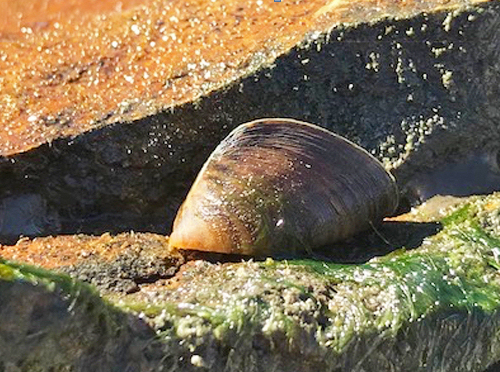The Kansas Department of Wildlife, Parks and Tourism has confirmed the presence of invasive zebra mussels in Geary State Fishing Lake in Geary County. Zebra mussel larvae, also called veligers, were detected in routine samples collected by KDWPT staff. With this discovery, staff returned to the lake and located an established population of adult zebra mussels. Zebra mussels are just one of the non-native aquatic nuisance species (ANS) that threaten our waters and native wildlife. To monitor their occurrence, KDWPT staff collect samples from more than 100 waterbodies across the state.
The 97-acre state fishing lake, owned and operated by KDWPT, is 10 miles south of Junction City, on US Hwy 77. The lake and surrounding wildlife area are popular with anglers, hunters and hikers, and provide a variety of other outdoor activities.
While the zebra mussel population is currently small, there is no known method to completely rid a lake of this invasive species. The zebra mussels likely “hitchhiked” to the lake with unsuspecting lake-goers. Adults can attach to boats or other equipment and the microscopic zebra mussel veligers may be present in any water originating from an infested lake or stream. Densities as high as 1,000 veligers per gallon have been recorded in Kansas waters.
“Anyone transferring water, mud, or vegetation between waterbodies has the potential to spread aquatic nuisance species,” said Chris Steffen, aquatic nuisance species coordinator for KDWPT. “If everyone took the appropriate steps to clean, drain, and dry their boats, bait buckets and other recreational equipment before moving between lakes, we could prevent the spread of zebra mussels and other aquatic nuisance species.
Geary State Fishing Lake will be added to the list of Kansas ANS-designated waters, and notices will be posted at various locations around the lake. Live fish may not be transported from ANS-designated waters. The sharp-shelled zebra mussels attach to solid objects, so lake-goers should be careful when handling mussel-encrusted objects and when grabbing underwater objects when they can’t see what their hands may be grasping. Visitors should protect their feet when walking on underwater or shoreline rocks.
To prevent further spread of ANS, anyone using any body of water must follow regulations and precautions:
- Clean, drain and dry boats and equipment between uses
- Use wild-caught bait only in the lake or pool where it was caught
- Do not move live fish from waters infested with zebra mussels or other aquatic nuisance species
- Drain livewells and bilges and remove drain plugs from all vessels prior to transport from any Kansas water on a public highway.
To report a possible ANS, contact Chris Steffen at 620-342-0658, [email protected]. To learn more about ANS in Kansas or to see a list of ANS-designated waters, visit ProtectKSWaters.org.
ABOUT ZEBRA MUSSELS
Zebra mussels are dime-sized mollusks with striped, sharp-edged, two-part shells. They can produce huge populations in a short time and do not require a host fish to reproduce. A large female zebra mussel can produce 1 million eggs, which develop into microscopic veligers that are invisible to the naked eye. Veligers drift in the water for at least two weeks before they settle out as young mussels. They quickly grow to adult size and reproduce within a few months.
After settling, zebra mussels develop byssal threads that attach their shells to submerged hard surfaces such as rocks, piers, and flooded timber. They also attach to pipes, water intake structures, boat hulls, propellers, and submerged parts of outboard motors. As populations increase, they can clog intake pipes and prevent water treatment and electrical generating plants from drawing water. In 2012, two Kansas communities, Council Grove and Osage City, experienced temporary water shortages from zebra mussel infestations before water intake structures could be cleaned up. Removing large numbers of zebra mussels to ensure adequate water flow can be labor-intensive and costly.
Zebra mussels are native to the Black and Caspian seas of western Asia and eastern Europe and were spread around the world in the ballast water of cargo ships. They were discovered in Lake St. Clair and the Detroit River in 1988 and quickly spread throughout the Great Lakes and other rivers including the Mississippi, Illinois, Ohio, Tennessee, Arkansas and Hudson. They were first discovered in Kansas in 2003 at El Dorado Reservoir. Despite public education efforts to alert boaters about the dangers of zebra mussels and how to prevent spreading them, the species continues to show up in new lakes every year. Moving water in boats and bait buckets has been identified as a likely vector.
Copyright © Rocking M Media, 2017. All Rights Reserved. No part of this story or website may be reproduced without Rocking M Media’s express consent.



